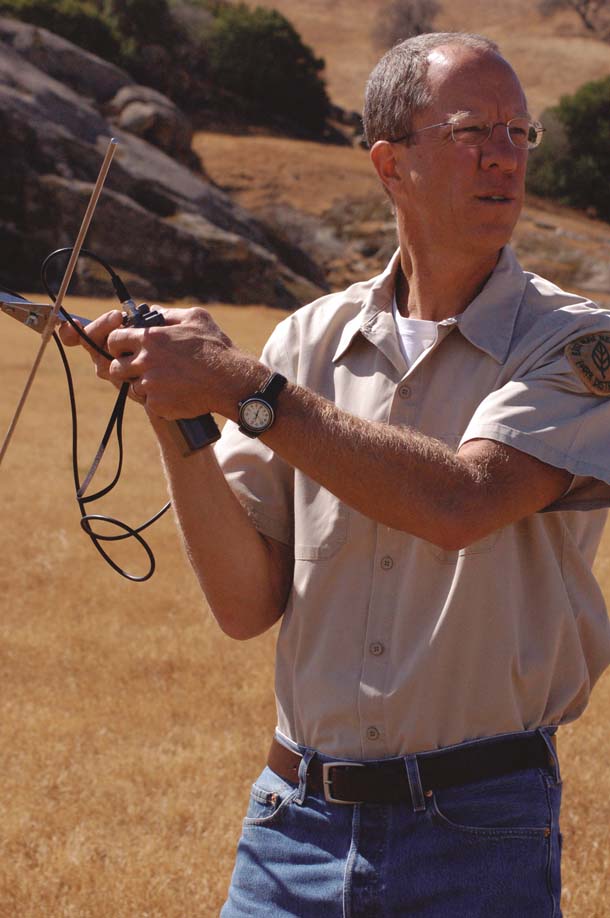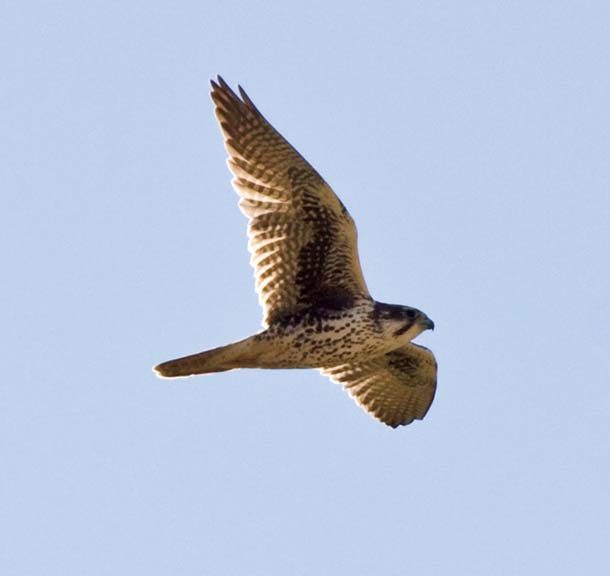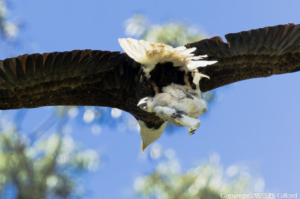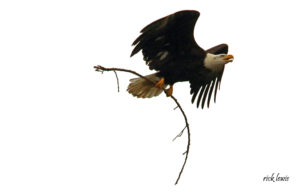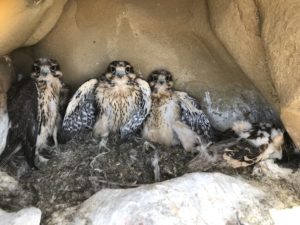“Has she seen us?” Near Brushy Peak in eastern Alameda County, Doug Bell has just spotted a prairie falcon, barely visible in an alcove high on a massive outcrop of sandstone. Bell, Wildlife Program manager for the East Bay Regional Park District, readies his antenna and picks up a single ping from the falcon’s direction. Then she’s up and traveling, vanished to the south. The pings grow fainter, then stop. “Now it’s up to the pilot to find her,” he says.
Bell knows this bird well. She hatched and was banded at a cliff-face nest site on Mount Diablo in 2004. The following year she paired with an adult male falcon nearby. They bred in 2006, but their two chicks were eaten by a great horned owl.
That was the year that Bell and researchers from the Santa Cruz Predatory Bird Research Group trapped her, using a decoy owl, and equipped her with a lightweight radio transmitter–“about 3 percent of body weight, like a 150-pound human wearing a four-and-a-half-pound backpack,” he explains.
The next year she relocated to Brushy Peak, replacing a resident female who had a fatal encounter with a wind turbine. Prairie falcons don’t build nests; they either occupy a vacant stick nest of a hawk or raven, or they lay their eggs in a sandy depression on a rock ledge. For her first Brushy Peak nesting attempt, the falcon chose a stick nest that heavy rains later washed out. Last spring, though, she fledged five young in a small–crowded–pothole in the rock.
- Doug Bell, Wildlife Program manager for the East Bay Regional Park District, uses radio telemetry equipment to track a prairie falcon as part of his studies of the birds’ movements. Photo by Ron Sullivan.
Does she recognize Bell? “She associates this green vehicle with banding her chicks,” he suggests. “I’ve had this female bop me in the head and almost knock me to my knees. As much as I love her, I’m afraid it’s a one-way street.”
The relationship between hawks and humans can indeed be complicated. Raptors have been objects of wonder and veneration, hunting partners, public enemies, conservation icons, and symbols of national identity. Some shun our company; others put up with it. Although the fall hawk migration at the Marin Headlands may be better known, the East Bay contains prime raptor habitat, and East Bay Regional Park District (EBRPD) lands like Brushy Peak provide splendid opportunities for viewing these charismatic birds.
The rock outcrops around Brushy Peak have been used by prairie falcons for decades, if not longer; in a 1935 National Geographic article, Frederick Fowler described watching a brood grow up there. But other historic nest sites lie vacant. Doug Bell began sampling East Bay prairie falcon nest sites five years ago. “It became clear to me that we’re down to about half the nests we used to have in the 1950s and 1960s,” he recalls. “Most years, there are only about seven nesting pairs. Why have we lost so many of our birds and what are the long-term prospects?”
Bell and other district employees study a wide range of wildlife, from red-legged frogs to least terns, and the falcon studies are among the most elaborate. Using radiotelemetry and tracking by small plane, Bell has learned where the East Bay’s prairie falcons go to forage. Typically, they’ll commute five to ten miles from the nest on foraging flights, though one male routinely flies from the Mount Diablo area to Bethany Reservoir in the Central Valley. First-year prairie falcons may wander much farther: Two young males banded near the Altamont Pass and Sunol Regional Wilderness were found dead in Montana.
“The prairie falcon is an obligate grassland bird,” says Bell. “They don’t forage in urban and suburban environments.” Peregrines can live on city pigeons, but prairie falcons need grasslands where their primary mammalian prey, the California ground squirrel, abounds. When the squirrels are inactive, the falcons fall back on grassland birds. Mapping the falcons’ travels is a way of identifying what Bell calls “the last best grasslands” that could be protected by the park district or through the new East Contra Costa County Habitat Conservation Plan. He sees prairie falcons as an indicator of healthy, sustainably managed grasslands, an umbrella species for other rare animals like the San Joaquin kit fox and the California tiger salamander.
Unlike the prairie falcon, other birds of prey have adapted to human-made landscapes. In 1927, Joseph Grinnell, the first director of the Museum of Vertebrate Zoology at UC Berkeley, and his assistant Margaret Wythe published a “Directory to the Bird-life of the San Francisco Bay Region.” Grinnell and Wythe knew turkey vultures only as summer visitants, migrating south by October. White-tailed kites were “rather rare,” nesting mostly in the Santa Clara Valley. Cooper’s hawks were “sparse and local residents”; the redshouldered hawk was a “rare resident.”
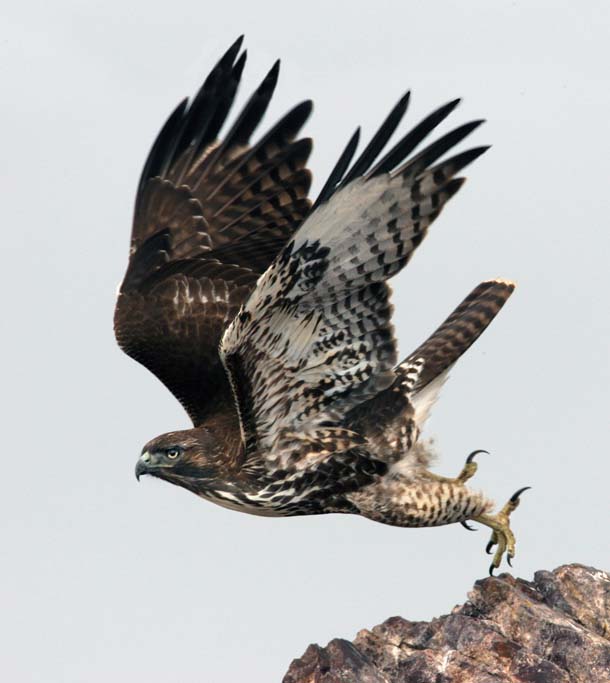
- Red-tailed hawk. Photo by Ron Wolf.
All that has changed. Turkey vultures have become year-round residents. The white-tailed kite made a dramatic comeback from near-extinction, exploiting farmlands’ rodent populations. Today the kites nest in most East Bay parks that have grassland for foraging and trees for roosting. Red-shouldered hawks, once limited to riparian corridors, now inhabit suburban neighborhoods and city parks. Cooper’s hawks have made an adaptive shift from remote woodlands to urban areas, where they nest in street trees and feed on pigeons, doves, and other birds. In Berkeley, where Ralph Pericoli runs the Cooper’s Hawk Intensive Nest Survey for the Golden Gate Raptor Observatory, that switch can be dated to 20 years ago when a firefighter who was also a falconer and raptor rehabber spotted some fledgling “Coops” on the roof of his firehouse. Pericoli says Berkeley now averages 11 nests every year.
For the other falcons, indications are mixed. American kestrels are still widespread, and their numbers appear stable. The peregrine falcon’s situation remains tenuous. Hard hit by DDT, peregrines were listed as endangered in 1975 and have inspired special restoration efforts. In the early 1990s, the EBRPD worked with the Santa Cruz research group to cross-foster captive-hatched peregrine chicks into prairie falcon nests in Mission Peak Regional Park and the Sunol and Ohlone regional wildernesses, hoping to reestablish a breeding population. At maximum in the late 1990s, seven inland East Bay peregrine territories were occupied; this year, only three. No one is sure why the falcons have declined.
One spectacular raptor has moved into a habitat niche that didn’t exist before the mid-20th century: freshwater reservoirs. According to the late, noted ornithologist Howard Cogswell (also an EBRPD board member from 1970 until 1982), there were no historic records of bald eagles nesting in the Bay Area before 1996. Then a pair settled in Del Valle Regional Park in the hills south of Livermore, where a reservoir, filled in the 1960s, is stocked with catfish, trout, and bass. Like Doug Bell’s prairie falcon, the eagle female is a bird with a past. She was taken from a nest near Juneau, Alaska, in 1991, captive-reared, and released in the Ventana Wilderness, where the Ventana Wildlife Society was trying to reestablish the species. Between Ventana and Del Valle, she spent a few years in Monterey and San Luis Obispo counties.
“I would have bet good money that the birds would nest at San Antonio Reservoir or Calaveras Reservoir, both nearby in protected watersheds with restricted human access,” says EBRPD Stewardship Manager Joe DiDonato. Instead they chose Del Valle, which had around 15,000 visitors last Labor Day weekend. Other bald eagles have since colonized Calaveras and San Pablo reservoirs, and a fourth pair may be nesting at Los Vaqueros Reservoir, southwest of Brentwood.
“We’re now seeing a lot more bald eagles using lakes at public recreation areas,” DiDonato says. “At Del Valle we were really surprised. It seemed like there would be a natural conflict between eagles and boaters and fishermen, but there hasn’t been any.” They’ve been known to launch from their lakeside perches and snag fish in front of startled boaters. And it’s not just fish they’re after; one biologist saw the female eagle steal a ground squirrel from a bobcat.
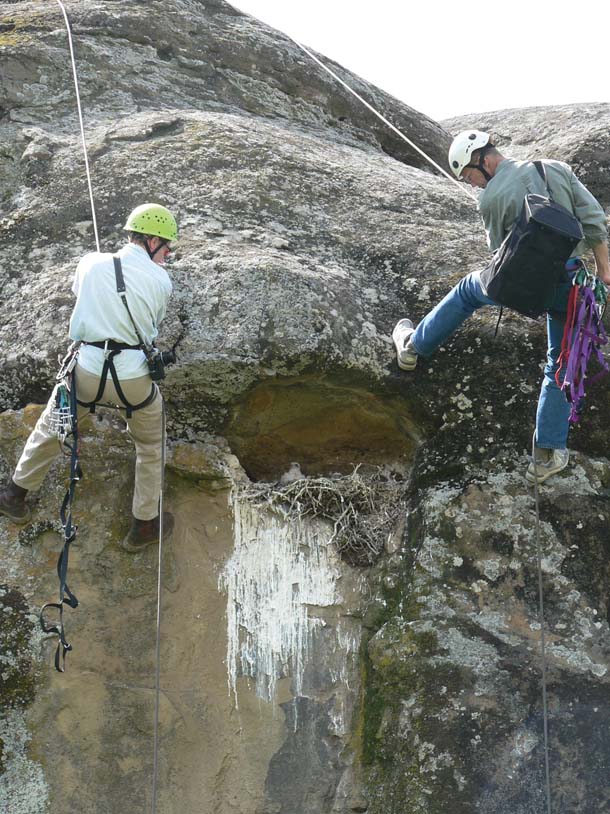
- EBRPD wildlife biologists Steve Bobzien (left) and Doug Bell (right) descend to a prairie falcon nest to band the chicks. Photo by Leslie Riser, courtesy East Bay Regional Park District.
Another great raptor, the golden eagle, seems to be holding steady in numbers–but its future is uncertain. Joe DiDonato spent part of the late 1980s in a cabin in the Ohlone Wilderness, surveying eagles. He recalls that his estimate of more than 20 nests between Mission Peak and Del Valle was met with incredulity. But later surveys by biologists Grainger and Teresa Hunt, who did extensive trapping, banding, and radio-telemetry, confirmed that number. “We have the highest density of nesting golden eagles anywhere in the world,” DiDonato says. In part that’s due to a bountiful prey base, primarily ground squirrels. A resurvey by the Hunts in 2005 found that all 58 territories documented in 2000 were still occupied. Most local goldens, sensitive to human disturbance, nest in remote places. The resident pair at Sibley Regional Preserve in the Oakland Hills are anomalous in their tolerance of the park’s steady stream of visiting people and dogs.
Local golden eagle populations may be limited by wind-farm mortality. An estimated 40 to 116 are killed every year in collisions with wind turbine blades in the Altamont Hills; 42 of 257 birds radio-tagged by the Hunts became turbine fatalities between 1994 and 2000. The open question is whether the birds can sustain these losses. “If you consider all eagles nesting within 30 kilometers of the wind farms, they don’t produce enough to ‘feed’ the wind farms,” says Doug Bell. Our eagle population is sustained by immigrants from areas outside the Bay region.
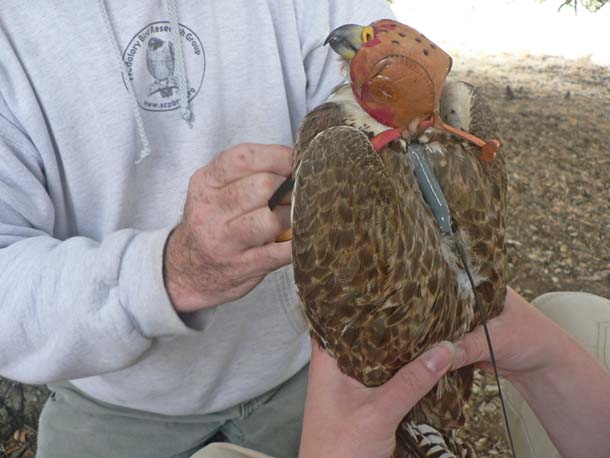
- Brian Latta of the Santa Cruz Predatory Bird Research Group fits a transmitter harness to an adult female prairie falcon, which is wearing a hood that helps it stay calm. The transmitters have helped researchers map out the healthy grasslands, both protected and unprotected, where the falcons hunt. Photo by Doug Bell, courtesy East Bay Regional Park District.
Bell has been involved with research on wind turbine raptor kills. In 2005, the park district acquired land next to Vasco Caves Regional Preserve that came with an existing wind farm lease, so the district is experimenting with controlled grazing by sheep to modify habitat and reduce ground squirrel populations around the towers, aiming to make wind farms less attractive to raptors. Park staff also monitored how golden eagles and other raptors use the landscape around wind turbines. To get a better handle on the accuracy of mortality rates, Bell used automated cameras to measure scavenger bias: how quickly a coyote or other scavenger can remove a raptor carcass before human searchers find it. “Carcasses disappear much faster than previous studies assumed,” he says. “That means the overall mortality rate has to be adjusted upward.” He hopes the Vasco Caves study will inform a pending decision on equipping the preserve’s wind farm with a new generation of taller turbines whose impact on birds has not yet been determined.
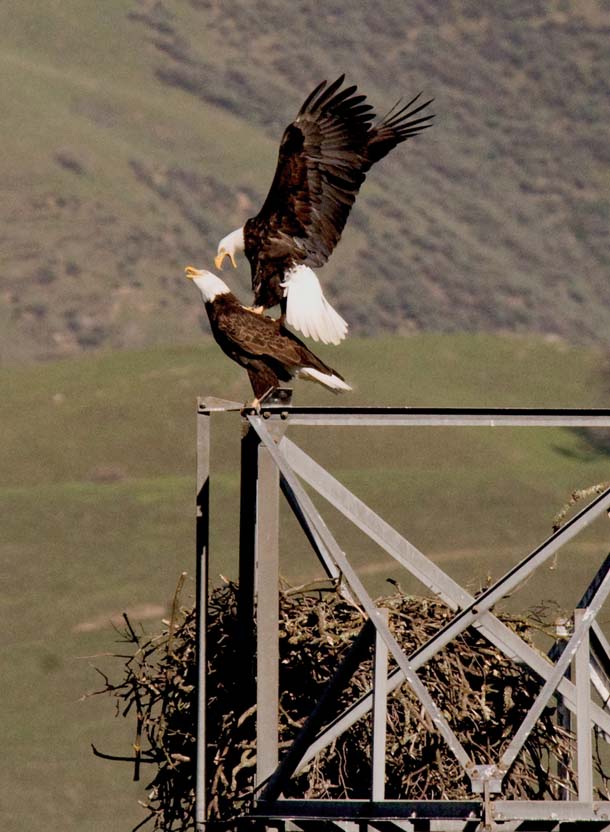
- Bald eagles mating above their nest near the Calaveras Dam, south of Sunol Regional Wilderness. The first record of bald eagles nesting in the Bay Area was in 1996. Photo by Stephen Rosenthal.
The East Bay’s resident eagles, falcons, and other raptors are joined each winter by a host of visitors unable to find prey on their northern breeding grounds. Up to 17 bald eagles have wintered at San Antonio Reservoir. In the shoreline parks like Point Pinole, Hayward Shoreline, and Coyote Hills, northern harrier numbers are augmented by migrants. These parks are also good places to see wintering merlins, small falcons that nest in the northern tundra. Migrant red-tailed hawks join with the many resident redtails to flood the Coast Range, and ferruginous hawks from the Great Plains show up at Brushy Peak.
Despite the density of raptors in winter, hawk migration in the East Bay remains enigmatic. Visual navigators, raptors follow coastlines–funneling through the Golden Gate in fall–and interior mountain ranges. Fall migration is more visible than the return trip in spring, when the front of moving birds is more dispersed, numbers have been reduced by winter mortality, and migrants avoid coastal headwinds. DiDonato says he has spent years looking for inland sites comparable to the Marin Headlands. What GGRO volunteer Harv Wilson observed in the spring of 2007 gave a tantalizing hint of where the migrants might be.
In mid-March, Wilson noticed a concentration of raptors near Crockett Hills Regional Park, at the south end of the Carquinez Bridge. He returned for 22 days between March 20 and April 24, joined by other hawk watchers. Together they logged 7,145 northbound raptors of 14 species, redtails predominating, passing through at a rate of 94 per hour. “That’s extremely good for spring migration,” Wilson says. At eastern hawk-watch sites like Pennsylvania’s Hawk Mountain, the spring passage rate is only 20 per hour.
Last year Wilson began monitoring Crockett Hills in February, but saw only the resident redtails. No large raptor movements were reported nearby. “If there was a large migration event,” Wilson says, “we would have heard of it.” But he plans to be back in spring 2009. Crockett Hills rangers have told him they’ve seen lots of raptors in the last five years, so he’s betting 2007 was not a fluke.
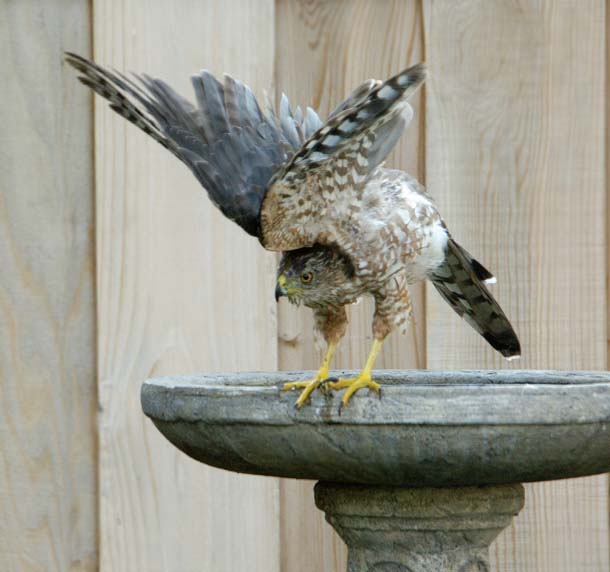
- A Cooper’s hawk cools off at a backyard birdbath in Concord. These hawks have thrived in urban and suburban areas, such as Berkeley, where there are plenty of tall trees for nests, and plenty of songbirds for dinner. Photo by Mike DiCarlo.
East Bay residents have been paying attention to hawks, falcons, and eagles for centuries. At Vasco Caves east of Mount Diablo, ancient charcoal-and-hematite paintings depict long-winged raptors: condors, golden eagles, maybe prairie falcons; Prairie Falcon was a culture hero of the Miwok and Yokuts who used the site.
Sometimes the relationship between human and hawk has been less positive. Farmers and hunters persecuted them; egg collectors looted their nests. Even today, there are those who lack respect for raptors: A visitor at Sibley threw a Frisbee at the golden eagles’ nest to get the birds to react. Raptors with gunshot wounds are still being brought to the Lindsay Wildlife Museum in Walnut Creek for treatment, along with victims of collisions with vehicles, power lines, and windows, entanglement with barbed wire, and rodenticide poisoning.
But Doug Bell sees a growing coalition of public agencies and private landowners working together for the good of hawks, falcons, eagles, and other birds of prey. “A hundred years from now I want prairie falcons to still be nesting here,” he says, as we scan for raptors at Vasco Caves. “With that we’ll have a whole host of other beautiful grassland-dependent species, and they all need the same healthy ecosystem.”

.jpg)
